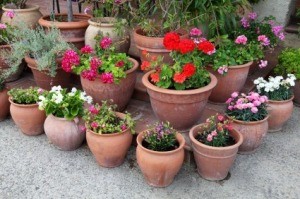 Just like their soil-dwelling counterparts, vegetables and flowers grown as container plants are susceptible to a variety of pests and diseases. Most are a result of environmental conditions, such as in correct moisture, temperature and light conditions. If you enjoy growing plants in containers, keep an eye open for the following symptoms as an early warning sign that something is wrong.
Just like their soil-dwelling counterparts, vegetables and flowers grown as container plants are susceptible to a variety of pests and diseases. Most are a result of environmental conditions, such as in correct moisture, temperature and light conditions. If you enjoy growing plants in containers, keep an eye open for the following symptoms as an early warning sign that something is wrong.
Leaf, flower or bud drop: Plants experiencing some type of shock may suddenly drop their leaves, buds, or flowers. This often happens as a result of being transplanted or moved to a new location with different light or temperature conditions than they are used to. Another cause can be soil moisture extremes; either over-saturated or dried-out. Also, check that you are not over-feeding or using wrong type of fertilizer on your plants.
Failure to flower: Buds that suddenly disappear or fail to open may have been eaten or attacked by birds, weevils or caterpillars. If they simply fail to appear, yet the plant is making plenty of foliage, you may be over-feeding. Unexpected fluctuations in light or temperature (e.g. a sudden cold snap) can also prevent plants from flowering and setting fruit.
Distorted flowers or fruits: Pest damage and fungus infestations often result in distorted flowers and fruits. Caterpillars and beetles are common culprits, but fruit trees in containers might also be suffering from scab or rot. Cracked fruit is usually the result of inconsistent (uneven) watering, and may cause splits, green blotchy patches or blossom-end rot in tomatoes. If root vegetables are cracking, it's probably a sign that you are not watering frequently enough.
Leaves turning yellow: If your plant looks generally pale and sickly or a large number of leaves start to turn yellow and drop off, you are probably over-watering it. Ironically, a plant that is suffering from a lack of water will often present these exact same symptoms. Yellowing leaves that do not drop is usually an indication of a soil imbalance. This could be due to a pH problem or from watering your plants with 'hard' water. Poor growth combined with yellow leaves may indicate a lack of nutrients and the need for more fertilizer.
Brown patches on leaves: Dead, dried out brown patches on leaves may be a sign of frost damage or that the plant is suffering from sunscald. If you're sure this isn't the case, you may be over-feeding or not providing plants with enough potash (potassium). 'Scorch' marks sometimes appear on leaves accidentally splashed with liquid fertilizer or pesticides. Areas of brown discoloration can also be a symptom of diseases such as scab, rust, black spot, or due to an infestation of mites.
Mottled leaves: Mottling (patches or spots of different colors) is a common symptom of virus and fungal diseases 'especially when combined with stunted or distorted growth. A virus may cause yellow stripes or blotches, whereas fungal diseases like sooty mold and powdery mildew produce black or silver mottling.
Holes in leaves: Holes in leaves are usually caused by insects. These can run the gamut from caterpillars, slugs and snails, and earwigs; to leaf-cutter bees, weevils, and a variety of beetles. Fruit trees such as plums, peaches, and cherries may develop brown patches and holes on the leaves if they run short on water or nutrients.
Distorted leaves: Crinkled and oddly-shaped leaves may indicate an insect problem or some type of virus infection. Aphids cause the leaves of some fruit trees to curl up and mites and sawflies will curl the leaves of many other plants. Larvae from the fruittree leafroller spin webs at the branch tips of roses and most fruit and ornamental trees, then feeds on the enclosed buds and leaves.
Wilting plants: When a container plant starts to wilt, it usually indicates that the soil is too dry. If this is the case, watering the wilting plant should revive it pretty quickly. If dry soil isn't the cause, the roots may have suffered damage from the likes of burrowing pests, fungal diseases, or a buildup of fertilizer salts. If the problem doesn't appear to be the in soil or the roots, the plant may simply be suffering from too much heat and should be temporarily moved to a cooler location.
Root problems: The most common root problem is fungus rot caused by over-watering'especially during cold, damp weather. Roots may also be eaten or damaged by insect pests such as caterpillars, maggots, and grubs. Root problems can be minimized by avoiding over-watering and using sterilized potting soil to help reduce the chance of soil borne insects.
Poor growth or slow growth: If your plants are slow to get started or mid-season growth appears poor, you may be under-feeding them. Pale leaves and stems and leggy growth usually indicates under-feeding. It may also be a sign that your container plants need more sun. Check to make sure that the plant's roots have not become pot-bound, as this also results in poor, or stunted growth.